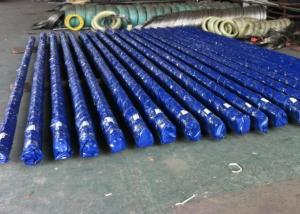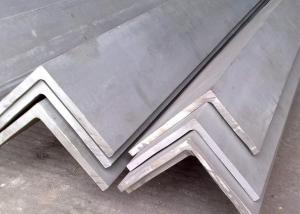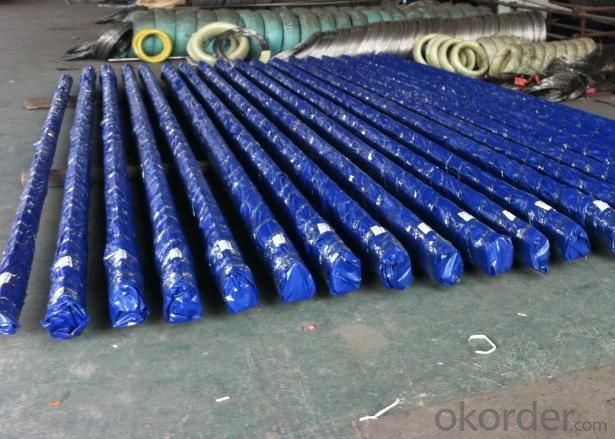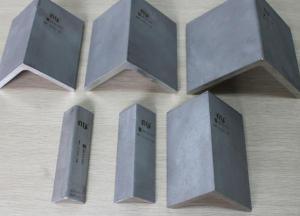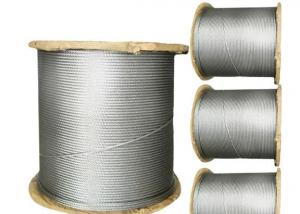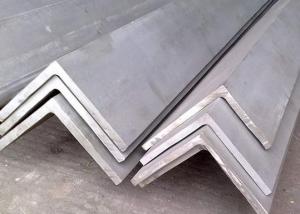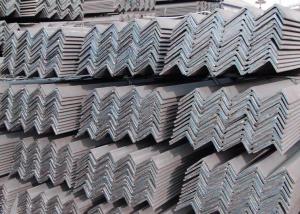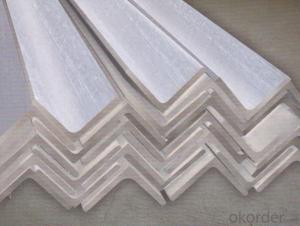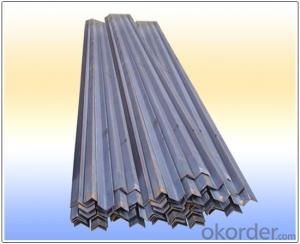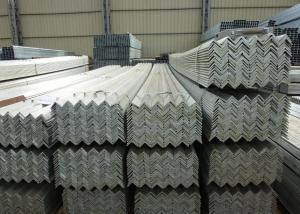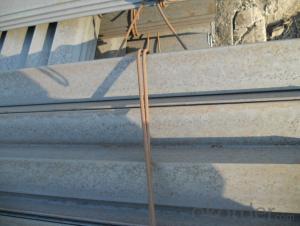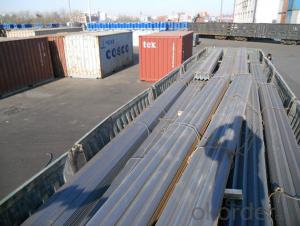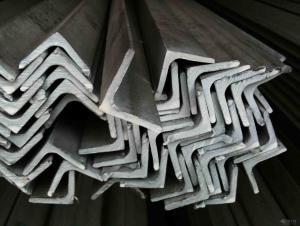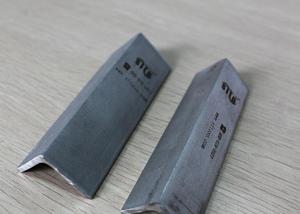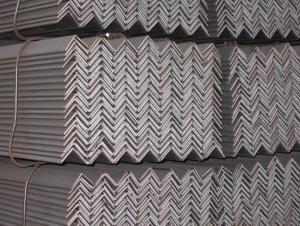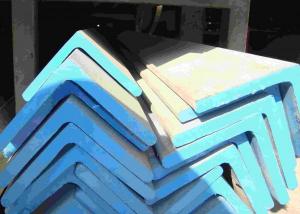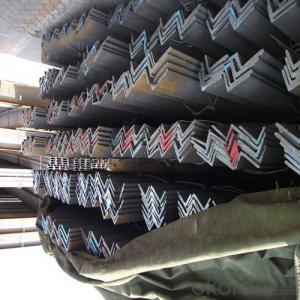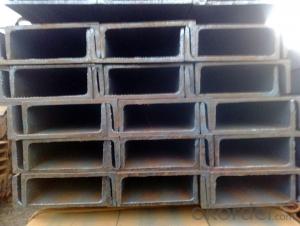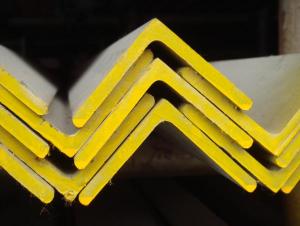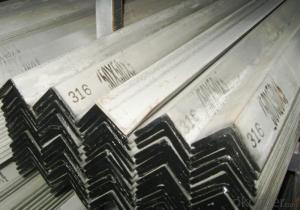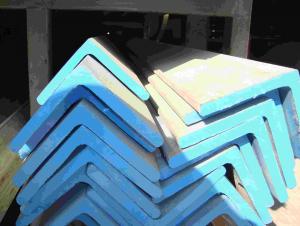Best Quality for Equal Stainless Steel Angles
- Loading Port:
- China Main Port
- Payment Terms:
- TT or LC
- Min Order Qty:
- 1 Ton m.t.
- Supply Capability:
- 500 Tons Per Month m.t./month
OKorder Service Pledge
OKorder Financial Service
You Might Also Like
Stainless Steel Angles
General Information of Stainless Steel Angles
1. Grade: SS200, 300,400 series
2. Size: 25×25×3 mm-100×100×10mm
3. Process: HRAP
4. Length: 2-6m
5. Shape: Equal
6. Delivery: within 20 days
7. MOQ: 1 ton
8. Certificate: ISO 9001:2008, SGS
9. Package: Standard Export Packing, or put into wooden boxes according to your requirement
10. Application: Construction, Marine, Industry and so on
Specification of Stainless Steel Angles
Name | Stainless Steel Angles | |||||
Standard | ASTM A554, A312, A249, A269 and A270 | |||||
Material Grade | 304,316,201,202, 316L,430 | |||||
Length | 6m or as customers' request | |||||
Tolerance | a) Thickness: +/-0. 15mm | |||||
b) Length:+/-4. 5mm - 0mm | ||||||
Surface | 180G, 320G, 400G Satin / Hairline(Matt Finish, Brush, Dull Finish) 400G, 500G, 600G or 800G Mirror finish | |||||
Application | Decoration construction, upholstery, industry instruments | |||||
Test | Squash test, Extended test, Water pressure test, Crystal rot test, Heat treatment, NDT | |||||
Chemical Composition of Material | Composition Material | 201 | 202 | 304 | 316 | 430 |
C | ≤0.15 | ≤0.15 | ≤0.08 | ≤0.08 | ≤0.12 | |
Si | ≤1.00 | ≤1.00 | ≤1.00 | ≤1.00 | ≤1.00 | |
Mn | 5.5-7.5 | 7.5-10 | ≤2.00 | ≤2.00 | ≤1.00 | |
P | ≤0.06 | ≤0.06 | ≤0.045 | ≤0.045 | ≤0.040 | |
S | ≤0.03 | ≤0.03 | ≤0.030 | ≤0.030 | ≤0.030 | |
Cr | 16-18 | 17-19 | 18-20 | 16-18 | 16-18 | |
Ni | 3.5-5.5 | 4-6 | 8-10.5 | 10-14 | ||
Mo | 2.0-3.0 | |||||
Mechanical Property | Material Item | 201 | 202 | 304 | 316 | |
Tensile Strength | ≥535 | ≥520 | ≥520 | ≥520 | ||
Yield Strength | ≥245 | ≥205 | ≥205 | ≥205 | ||
Extension | ≥30% | ≥30% | ≥35% | ≥35% | ||
Hardness (HV) | <253 | <253 | <200 | <200 | ||
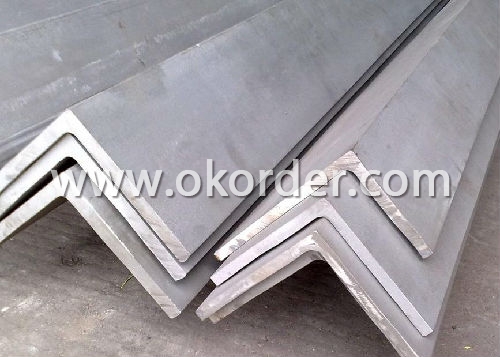
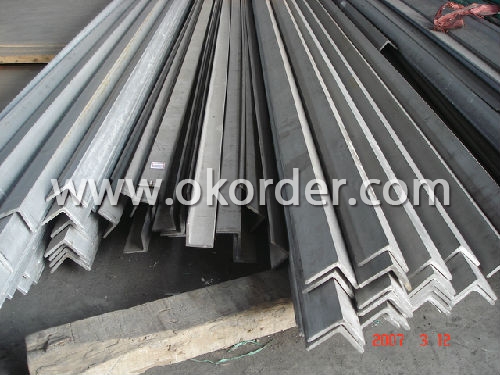
- Q: Can stainless steel angle be used in noise control applications?
- Indeed, noise control applications can certainly incorporate stainless steel angle. Renowned for its exceptional strength and durability, stainless steel proves to be an impeccable choice for implementing effective noise control measures. By utilizing stainless steel angle, one can construct barriers, enclosures, and partitions that effectively diminish noise transmission. Moreover, its corrosion resistance properties render it highly suitable for outdoor noise control applications. Furthermore, the ease with which stainless steel angle can be fabricated and installed enables the creation of tailored noise control solutions.
- Q: Can stainless steel angles be used in chemical processing industries?
- Yes, stainless steel angles can be used in chemical processing industries. Stainless steel is highly resistant to corrosion and has excellent strength and durability, making it suitable for handling various chemicals and corrosive substances in industrial settings. Additionally, stainless steel angles can withstand high temperatures and pressures, making them an ideal choice for chemical processing applications.
- Q: How do stainless steel angles contribute to the overall functionality of a structure?
- The inclusion of stainless steel angles is crucial for improving the overall functionality and structural integrity of buildings and other structures. These angles, which are commonly utilized in construction projects, offer a multitude of advantages that contribute to the durability and dependability of structures. To begin with, stainless steel angles provide exceptional strength and support to structures. Their L-shaped design grants stability and reinforcement to various structural elements. They can be employed as load-bearing components, transferring weight and forces from the structure to the foundation or other structural elements. This aids in distributing the load evenly, preventing excessive stress in specific areas and reducing the risk of structural failure. Furthermore, stainless steel angles possess outstanding resistance to corrosion, making them highly suitable for diverse environmental conditions. The presence of chromium in stainless steel forms a protective oxide layer on its surface, preventing rust and corrosion. This resistance to corrosion is particularly important for structures exposed to moisture, chemicals, or harsh weather conditions, as it ensures the long-lasting nature and dependability of the structure. Stainless steel angles also offer versatility in terms of design and construction. They are available in various sizes, thicknesses, and grades, allowing architects and engineers to select the most appropriate angles for their specific design requirements. The flexibility in dimensions and shapes enables easy incorporation into different structural configurations, providing endless possibilities for design. Moreover, stainless steel angles are low-maintenance components. The material's resistance to staining, scratching, and general wear and tear reduces the need for frequent repairs or replacements. This not only saves costs but also minimizes interruptions to the structure's functionality during maintenance activities. Additionally, stainless steel angles provide aesthetic benefits. Their sleek and polished finish adds a touch of elegance and modernity to the structure's appearance. This makes them ideal for applications where both functionality and visual appeal are desired, such as architectural features, decorative elements, or interior design. In conclusion, the inclusion of stainless steel angles significantly enhances the overall functionality of structures by providing strength, stability, corrosion resistance, versatility, low maintenance, and aesthetic appeal. Their wide range of applications and benefits make them essential components in construction projects, ensuring the long-lasting nature and dependability of modern structures.
- Q: Can stainless steel angles be used in the production of oil and gas equipment?
- Indeed, the utilization of stainless steel angles is possible in the manufacturing of equipment for oil and gas purposes. With its exceptional resistance to corrosion and ability to endure harsh surroundings, stainless steel proves to be an optimal material for such applications. The fabrication of diverse components, including frames, brackets, supports, and structural elements, can be accomplished using stainless steel angles for oil and gas equipment. The remarkable robustness and longevity of stainless steel guarantee the reliability of the equipment, even in challenging circumstances. Moreover, the ease of cleaning and maintenance associated with stainless steel makes it a favored choice for oil and gas equipment, where hygiene and safety are of utmost importance.
- Q: What are the advantages of stainless steel angles?
- There are several advantages of stainless steel angles that make them a popular choice in various industries and applications. Firstly, stainless steel angles are highly durable and have excellent corrosion resistance. This makes them ideal for use in environments that are exposed to moisture, chemicals, or extreme temperatures. Unlike other materials, stainless steel angles do not rust or corrode easily, ensuring long-term durability and structural integrity. Secondly, stainless steel angles offer exceptional strength and load-bearing capabilities. They can withstand heavy loads and stresses, making them suitable for structural applications such as construction, engineering, and infrastructure projects. The high strength-to-weight ratio of stainless steel angles allows for the creation of lightweight and slender structures without compromising on strength or stability. Additionally, stainless steel angles have an attractive appearance and a smooth, polished surface finish. This makes them aesthetically pleasing and easy to clean, making them suitable for applications in the food and beverage industry, architectural designs, and decorative purposes. The corrosion resistance of stainless steel angles also ensures that they maintain their appearance and integrity over time, reducing the need for frequent maintenance or replacement. Moreover, stainless steel angles are highly versatile and can be easily fabricated into various shapes and sizes to meet specific project requirements. They can be welded, bent, cut, or machined without losing their structural properties. This flexibility allows for customization and adaptability, making stainless steel angles suitable for a wide range of applications. Lastly, stainless steel angles are a sustainable and environmentally friendly choice. They are 100% recyclable, meaning that they can be reused or repurposed without losing their properties. Stainless steel is also made from natural elements and does not emit harmful substances during production or use, making it a safe and sustainable material option. In conclusion, the advantages of stainless steel angles include their durability, corrosion resistance, strength, versatility, attractive appearance, and sustainable nature. These properties make stainless steel angles a reliable and cost-effective choice for various industries and applications.
- Q: Can stainless steel angle be used in cryogenic applications?
- Yes, stainless steel angle can be used in cryogenic applications. Stainless steel is known for its excellent corrosion resistance and high strength at low temperatures, which makes it a suitable material for cryogenic environments. Stainless steel angles can withstand the extreme cold temperatures and maintain their structural integrity, making them ideal for applications such as cryogenic storage tanks, pipelines, and equipment used in the production and transportation of liquefied gases. Additionally, stainless steel's resistance to thermal expansion and contraction helps to ensure dimensional stability in cryogenic systems.
- Q: How do you calculate the moment of inertia of a stainless steel angle?
- To determine the moment of inertia of a stainless steel angle, one can utilize the formula for the moment of inertia of a beam or structural shape. This value serves as a measure of the angle's resistance to rotational motion along a specific axis. To calculate the moment of inertia, it is necessary to have knowledge of the angle's dimensions and shape. The formula for the moment of inertia of a beam is as follows: I = (b * h^3) / 12 Here, I represents the moment of inertia, b represents the angle's base width, and h represents the angle's height or vertical dimension. By substituting the values for the base width and height of the stainless steel angle into this formula, one can determine its moment of inertia. It is vital to ensure that the dimensions used in the calculation are consistent with the chosen units of measurement (e.g., inches or centimeters). It is important to note that the moment of inertia calculation assumes that the stainless steel angle is a solid, homogeneous object with a uniform distribution of mass. If the angle possesses cutouts, holes, or variations in thickness, the calculation may necessitate modification. Moreover, if the stainless steel angle does not conform to a simple L-shape and incorporates additional flanges or curved sections, the moment of inertia calculation may become more intricate, requiring supplementary formulas or techniques. In such cases, it is advisable to consult relevant engineering resources or seek expert advice.
- Q: Can stainless steel angles be submerged in water?
- Yes, stainless steel angles can be submerged in water without any issues. Stainless steel is highly resistant to corrosion and rust, making it a suitable material for applications involving water exposure. The chromium content in stainless steel forms a protective layer on the surface, preventing the metal from reacting with water and other corrosive elements. Submerging stainless steel angles in water will not cause any degradation or damage to the material, ensuring its durability and longevity even in wet environments.
- Q: What are the temperature limits for stainless steel angles?
- Depending on the specific grade of stainless steel, the temperature limits for stainless steel angles can vary. Stainless steel is generally known for its exceptional heat resistance and ability to withstand high temperatures. However, it is crucial to consider the grade of stainless steel being utilized, as different grades have different temperature limits. For instance, the commonly used grade of stainless steel, 304 stainless steel, has a temperature limit of approximately 870°C (1600°F). This grade is suitable for numerous applications that involve high temperatures, such as industrial furnaces, heat exchangers, and exhaust systems. On the other hand, other stainless steel grades, like 316 stainless steel, offer even higher temperature limits. 316 stainless steel has a temperature limit of roughly 925°C (1700°F), making it suitable for more demanding applications that require extreme heat and corrosion resistance. It is important to note that factors such as the duration of exposure to high temperatures and the specific environment in which the angles are used can also influence the temperature limits for stainless steel angles. Therefore, it is recommended to consult the manufacturer's specifications or seek professional advice to determine the precise temperature limits for a specific grade of stainless steel angle in a particular application.
- Q: Can stainless steel angles be used in the production of aerospace components?
- Indeed, the utilization of stainless steel angles is possible in the manufacturing of aerospace components. Stainless steel is a highly adaptable material that showcases exceptional resistance to corrosion, formidable strength, and commendable mechanical properties. These characteristics render it appropriate for a variety of applications in the aerospace sector, such as structural components, fasteners, brackets, and supports. The construction of aircraft frames, wings, and fuselages commonly incorporates stainless steel angles due to their capacity to endure substantial stress and loads. These angles can be subjected to welding, machining, and shaping processes, enabling flexibility in the design and production of aerospace components. Moreover, stainless steel angles offer superior resistance against extreme temperatures and harsh environmental conditions, both of which are crucial factors within aerospace applications. In conjunction with its mechanical properties, stainless steel is also highly regarded in the aerospace industry for its immunity to corrosion. The arduous operational environments faced by aerospace components, including exposure to moisture, chemicals, and saltwater, necessitate materials capable of withstanding such conditions without succumbing to corrosion. Stainless steel angles, equipped with their innate corrosion resistance, offer a dependable solution for aerospace manufacturers. In summary, stainless steel angles provide a combination of strength, longevity, and corrosion resistance that positions them ideally for usage in the manufacturing of aerospace components. Their versatility and ability to meet the exacting demands of the industry have cemented their status as a popular choice among aerospace engineers and manufacturers.
1. Manufacturer Overview
| Location | Jiangsu,China |
| Year Established | 2002 |
| Annual Output Value | Above US$ 8 Million |
| Main Markets | China, East Asia, |
| Company Certifications | ISO9001:2000; |
2. Manufacturer Certificates
| a) Certification Name | |
| Range | |
| Reference | |
| Validity Period |
3. Manufacturer Capability
| a) Trade Capacity | |
| Nearest Port | Shanghai |
| Export Percentage | 40% |
| No.of Employees in Trade Department | 30 People |
| Language Spoken: | English;Chinese |
| b) Factory Information | |
| Factory Size: | Above 26,000 square meters |
| No. of Production Lines | Above 6 |
| Contract Manufacturing | OEM Service Offered;Design Service Offered |
| Product Price Range | Average |
Send your message to us
Best Quality for Equal Stainless Steel Angles
- Loading Port:
- China Main Port
- Payment Terms:
- TT or LC
- Min Order Qty:
- 1 Ton m.t.
- Supply Capability:
- 500 Tons Per Month m.t./month
OKorder Service Pledge
OKorder Financial Service
Similar products
Hot products
Hot Searches
Related keywords
